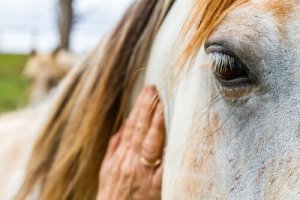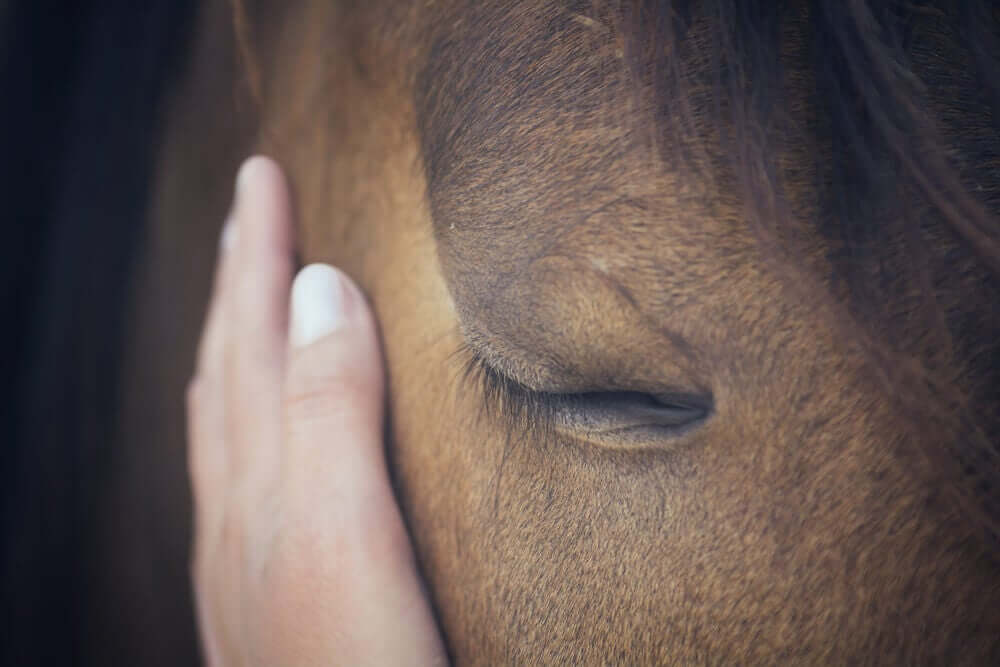Did You Know? Horses Can Interpret Human Emotions

Horses are very sensitive and receptive to stimuli in their environment. In fact, horses can interpret human emotions based on our expressions and tone of voice. They are not the only animal with this ability; dogs are also able to understand human emotions.
How horses can interpret human emotions
It’s amazing but true – horses can interpret human emotions. Since they are sociable animals, they have learned to identify and communicate with their own kind and with humans. This is because they have lived alongside humans for thousands of years.
Not only do they base their interpretations on facial expressions, but also on the tone of voice. Whether they already know the person or not is irrelevant. They are able to react to a face with a friendly expression and a calm voice as well as an irate face accompanied by growling and yelling.

In the face of negative stimulus, like an angry face, horses will turn their heads and look sideways with their right eye. This is because it’s the right hemisphere of their brains that processes signs of threat. At the same time, their heart rate increases and they become restless and clearly stressed. This cerebral ability allows them to anticipate negative situations.
Horses are communicative animals
In the wild, horses usually live in groups led by a mare and are prey to other animals. Therefore, they have developed a sort of language that they use to communicate among themselves.
The principal means of communication between horses is visual. Horses can interpret the body language of their peers by the position of their ears, head, legs, and body in general. Auditory communication is also very important.

- Communicating their location to the rest of the group
- Warning another horse of danger
- Welcoming another individual
- Transmitting affection or happiness
- As a sign of courting
- In order to find their young
Yes, horses can interpret human emotions
We can communicate with horses through facial language, body language and the tone of our voice. This fact has guided Monty Roberts—the man who listens to horses–throughout his career.
Marvin Earl “Monty” Roberts is a famous horse trainer and expert in equestrianism, horseback riding, and taming. He has based his work on communication with horses. Through communication, he establishes a relationship of respect and understanding between equines and humans. He leaves behind old concepts of dominance and punishment, methods which only manage to produce fear and frustration in animals.
The equine language of Monty Roberts
Monty calls his method “join up” and “follow up”, the objective of which seeks to establish a voluntary association between a human and a horse. The method doesn’t use pain or force in order to get the horse to accept a saddle, bridal, and being mounted.
None of this is new. The language of horses, known as Equus, is based on a sign system. The Native American Chickasaw tribe invented this language, which horse riders around the world came to adopt.
The three basic signs of this language are:
- Body postures, including the movements of a horse’s head, eyes, lips, and ears
- The horse’s tail
- Sounds made by the horse
Roberts identified more than 170 gestures through which human beings can communicate with horses.
As you can see, communication with horses is a reciprocal action. Humans and horses are both emitters and receptors of information. Man sends messages to horses through gestures, postures, and tones of voice that the horse can interpret. At the same time, horses respond through the position of their ears, head, body, and also through noises.
Horses are very sensitive and receptive to stimuli in their environment. In fact, horses can interpret human emotions based on our expressions and tone of voice. They are not the only animal with this ability; dogs are also able to understand human emotions.
How horses can interpret human emotions
It’s amazing but true – horses can interpret human emotions. Since they are sociable animals, they have learned to identify and communicate with their own kind and with humans. This is because they have lived alongside humans for thousands of years.
Not only do they base their interpretations on facial expressions, but also on the tone of voice. Whether they already know the person or not is irrelevant. They are able to react to a face with a friendly expression and a calm voice as well as an irate face accompanied by growling and yelling.

In the face of negative stimulus, like an angry face, horses will turn their heads and look sideways with their right eye. This is because it’s the right hemisphere of their brains that processes signs of threat. At the same time, their heart rate increases and they become restless and clearly stressed. This cerebral ability allows them to anticipate negative situations.
Horses are communicative animals
In the wild, horses usually live in groups led by a mare and are prey to other animals. Therefore, they have developed a sort of language that they use to communicate among themselves.
The principal means of communication between horses is visual. Horses can interpret the body language of their peers by the position of their ears, head, legs, and body in general. Auditory communication is also very important.

- Communicating their location to the rest of the group
- Warning another horse of danger
- Welcoming another individual
- Transmitting affection or happiness
- As a sign of courting
- In order to find their young
Yes, horses can interpret human emotions
We can communicate with horses through facial language, body language and the tone of our voice. This fact has guided Monty Roberts—the man who listens to horses–throughout his career.
Marvin Earl “Monty” Roberts is a famous horse trainer and expert in equestrianism, horseback riding, and taming. He has based his work on communication with horses. Through communication, he establishes a relationship of respect and understanding between equines and humans. He leaves behind old concepts of dominance and punishment, methods which only manage to produce fear and frustration in animals.
The equine language of Monty Roberts
Monty calls his method “join up” and “follow up”, the objective of which seeks to establish a voluntary association between a human and a horse. The method doesn’t use pain or force in order to get the horse to accept a saddle, bridal, and being mounted.
None of this is new. The language of horses, known as Equus, is based on a sign system. The Native American Chickasaw tribe invented this language, which horse riders around the world came to adopt.
The three basic signs of this language are:
- Body postures, including the movements of a horse’s head, eyes, lips, and ears
- The horse’s tail
- Sounds made by the horse
Roberts identified more than 170 gestures through which human beings can communicate with horses.
As you can see, communication with horses is a reciprocal action. Humans and horses are both emitters and receptors of information. Man sends messages to horses through gestures, postures, and tones of voice that the horse can interpret. At the same time, horses respond through the position of their ears, head, body, and also through noises.
All cited sources were thoroughly reviewed by our team to ensure their quality, reliability, currency, and validity. The bibliography of this article was considered reliable and of academic or scientific accuracy.
- Smith, Amy Victoria, Proops, Leanne, Grounds, Kate, Wathan, Jennifer and McComb, Karen (2016) Functionally relevant responses to human facial expressions of emotion in the domestic horse (Equus caballus). Biology Letters, 12 (2). p. 20150907.
- Kosuke Nakamura, Ayaka Takimoto-Inose, Toshikazu Hasegawa. Cross-modal perception of human emotion in domestic horses (Equus caballus). Scientific Reports, 2018.
- Feist, J. D., & McCullough, D. R. (1976). Behavior patterns and communication in feral horses. Zeitschrift für Tierpsychologie, 41(4), 337-371.
- Monty Roberts. El hombre que escucha a los caballos, 2017.
This text is provided for informational purposes only and does not replace consultation with a professional. If in doubt, consult your specialist.








